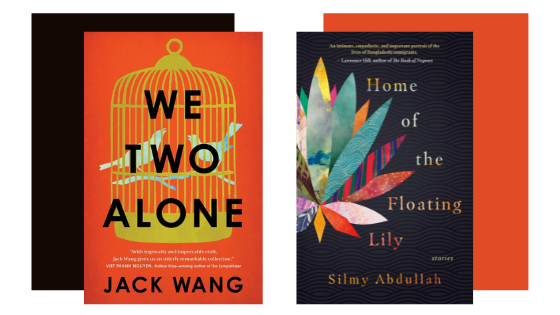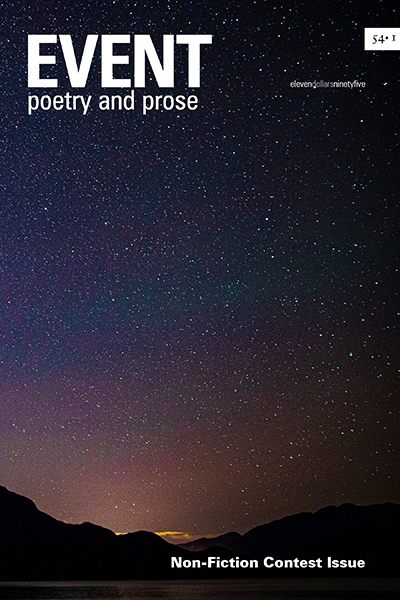Anuja Varghese Reviews Short Story Collections By Jack Wang and Silmy Abdullah for EVENT 50/2

Anuja Varghese Reviews:
Jack Wang, We Two Alone, House of Anansi Press, 2020
Silmy Abdullah, Home of the Floating Lily, Dundurn Press, 2021
One night in the spring, I started reading an article about Asian Heritage Month celebrations, which, for me, only served to highlight the lack of accountability for growing anti-Asian racism and violence. Around the same time, I finished We Two Alone, the debut short-story collection from Jack Wang. Both the article and Wang’s stories bring contradictory emotions into sharp focus, layering a kind of desperate hopefulness with a lurking despair.
We Two Alone is an insightful collection of stories that effectively draws the reader into the immigrant experience, showcasing the diversity within the Chinese diaspora across continents, time periods and social strata. There are war stories here—stories like ‘The Nature of Things’ and ‘The Night of Broken Glass’ that are literally set against the backdrop of war. But there are also stories of internal wars, apartments and hockey rinks and theatres becoming the battlegrounds on which Wang’s characters must fight for their happiness and humanity.
In ‘Everything in Between,’ we are introduced to a family trying to buy a house in South Africa in the 1960s. Faced with subtle and overt discrimination at every turn, they cannot ‘go back’ as none of them has ever actually been to China, nor can they go forward in the country they have come to call home. Meanwhile, in ‘Belsize Park,’ a man from a working-class Chinese family meets his white girlfriend’s affluent parents for the first time. Over the course of the visit, he comes to realize that although they both live in London, they will never be able to find home together.
The struggle to define home is a common theme throughout the book, but each story approaches the question from a unique angle. Looking back on her life, the narrator of ‘Everything in Between’ says: ‘I was born on one continent; I will die on another. This is the story of many. It’s everything in between that’s different.’ Wang’s work masterfully examines intersections of poverty, racism, classism and sexism, revealing their varied and devastating impacts on a marginalized people’s ability to ever truly feel at home. The stories in We Two Alone give us characters fighting for acceptance, for agency, for things as simple as the right to play hockey with other kids, to things as complex as the right to equality and love. Through these different struggles, we come to realize that home is less about where you live and more about winning these everyday battles, big and small.
One of the most affecting stories in the collection is the titular ‘We Two Alone.’ Structured as a novella, this final piece follows Leonard, an aging actor struggling to get his big break, to repair his crumbling relationship with his wife, and to come to terms with his own failing health. At a turning point in Leonard’s life, a time of loss and uncertainty, we see him and his almost ex-wife coming back together, but it is a complicated reunion: ‘But then, without a knock, the door opened, and she came to him. He didn’t know why or what it meant… Pity, sorrow, guilt, reflex—any reason was good enough.’ The disintegration and repair of relationships provides rich ground for Wang’s immersive prose throughout the collection, but it’s his ability to show both the fragility and fierceness of love in the face of personal tragedy and systemic oppression that sets this story apart.
About Leonard, we also learn, ‘Some people got to be every kind of crazy when he just wanted to be normal. To see himself in a story.’ This kind of meta-commentary, addressing both the character’s struggle and the real-world issues with problematic Asian representation and erasure in mainstream media, makes for a timely and thought-provoking read. Altogether, ‘We Two Alone’ is at once a moving love story, a scathing critique of an entertainment industry rampant with racism, and a quiet exploration of Chinese masculinity.
Where We Two Alone feels global in scope, like an invitation to travel from country to country with Wang’s cast of international characters, Home of the Floating Lily feels like an invitation to visit an old friend, to get cozy and catch up on the latest stories and scandals over a hot cup of milky tea. Silmy Abdullah’s debut short-story collection takes place mostly in Toronto, in the east end Crescent Oak neighbourhood, sometimes called Little Bangladesh or ‘Bangla Town.’ In the apartments and bungalows of Crescent Oak, we meet couples confronting infidelities of the heart, families unearthing old secrets, and parents struggling to balance expectation with reality in a new country their children will call home, even if they themselves may never feel the same.
There is an intimacy to Abdullah’s writing—like eavesdropping on a private conversation. In ‘A Secret Affair,’ Abid, a widower, embarks on a second marriage with Tahmina, never married and ‘hassle free,’ as his mother tells him. Abid tries to manage his sister-in-law’s expectations of loyalty, his new wife’s hopes for their new life together, and his own lingering grief, but in the process he puts all three on a dangerous collision course. Abdullah brings us to the core of Abid’s conflict, writing, ‘This, he could never explain to Tahmina—that he’d found a place for her in his heart while he wished at the same time that his first love had never left him…. This was against the rules of love as they’d been explained to him.’ While social and economic factors are certainly at play in the background of the characters’ lives, it is these deeply personal struggles that remain the very human heart of the book.
Throughout Abdullah’s stories, characters must cope with loss—of love, of home, of dreams. In particular, the sacrifices of women, whether as mothers, wives, daughters or daughters-in-law, are explored with a gentle touch. In ‘The Middle Path,’ Shaila is a mother of two boys who gives up a comfortable life to give them a better future. We understand that, ‘For her sons, she could easily leave behind her sprawling Arabian home to live in an apartment the size of her former bedroom. For them, she was ready for many more cruel Canadian winters that bit into her bones like a vicious animal.’ But when her sons choose paths very different from what she had imagined, Shaila must ask if it was their dreams she wanted to see come true, or her own.
Abdullah skillfully captures the voices of women, as shaped by love, loss and cultural expectations, allowing their hard truths and raw emotions to unfold on the page. By contrast, if there is one aspect of We Two Alone that gives me pause, it is perhaps Wang’s portrayal of female characters, who often seem there only to exert pressures on the men in their lives. Compared to the men, whose intricate inner lives dominate the book, their wives, girlfriends and lovers come off as somewhat one-dimensional in an otherwise beautifully multi-layered collection.
Like We Two Alone, Home of the Floating Lily ends with a titular story that reads like a novella, anchoring the book and tying many of its main themes together. ‘Home of the Floating Lily’ shifts between the perspective of Shahnaz, a single mother struggling to make ends meet and build a better life for her and her daughter, and Tasneem, Shahnaz’s teenaged daughter whose life changes drastically when she discovers her mother has been keeping a secret that throws their world into chaos. Although more meandering than ‘We Two Alone,’ both stories share the same emotional resonance, fully immersing the reader in the histories of the characters and weaving together sometimes contradictory perspectives that ask more questions of the reader than provide easy answers.
I never did finish that Asian Heritage Month article I started reading, but I don’t think I’m missing out. In both of these perceptive new collections, I was able to find more meaningful celebrations of Asian heritage, diversity and resilience than the contrived events and commercialized concern that well-meaning days or months of ‘awareness’ can offer. There is a certain melancholy to both of these books, yet they both end with moments of reconciliation and hope. From the everyday to the extraordinary (and the extraordinary within the everyday), these are stories that provide nuanced perspectives on the Asian immigrant experience, stories that are written to last, to haunt, to foster empathy and to build a broader worldview.
—Anuja Varghese













